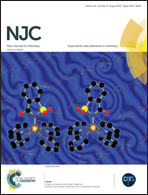Fluorene-based hyperbranched copolymers with spiro[3.3]heptane-2,6-dispirofluorene as the conjugation-uninterrupted branching point and their application in WPLEDs†
Abstract
A series of white light-emitting hyperbranched copolymers (P2–P5) consisting of polyfluorene/4,7-dithienyl-2,1,3-benzothiadiazole (DBT) branches and spiro[3.3]heptane-2,6-dispirofluorene (SDF) conjugated branching point have been synthesized and fully characterized. The effects of the branching degree on the thermal, photoluminescent and electroluminescent properties of the copolymers were investigated. The results suggest that the branching point helps to enhance both the thermal and spectral stabilities of the hyperbranched copolymers, and retain the energy transfer efficiency from fluorene to DBT unit. Efficient hyperbranched copolymer-based single-layer devices are achieved with CIE coordinates located at near (0.33,0.33). Especially, a device based on P4 (10 mol% of SDF) exhibits a doubled efficiency and 5.5-fold increase in luminance compared to the device based on the linear reference.
![Graphical abstract: Fluorene-based hyperbranched copolymers with spiro[3.3]heptane-2,6-dispirofluorene as the conjugation-uninterrupted branching point and their application in WPLEDs](/en/Image/Get?imageInfo.ImageType=GA&imageInfo.ImageIdentifier.ManuscriptID=C5NJ00667H&imageInfo.ImageIdentifier.Year=2015)

 Please wait while we load your content...
Please wait while we load your content...